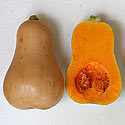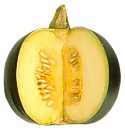|
Cucurbita (pumpkin, squash, marrow genus) Life
> eukaryotes >
Archaeoplastida >
Chloroplastida
>
Charophyta > Streptophytina > Plantae (land plants)
> Tracheophyta (vascular plants) > Euphyllophyta > Lignophyta (woody plants)
> Spermatophyta (seed plants) > Angiospermae (flowering plants)
> Eudicotyledons > Core Eudicots > Rosids > Eurosid I
> Order: Cucurbitales > Family: Cucurbitaceae
About 27 species, native to the warmer regions of the
Americas. Three well-known, domesticated vegetable species are in this genus and
cultivated in southern Africa, namely Cucurbita
maxima (Hubbard Squash and others), Cucurbita
moschata (Butternut) and
Cucurbita pepo (Pumpkin,
Gem Squash, Marrow, Courgette)
Species cultivated in southern Africa
List from Glen (2002).
Cucurbita
maxima (Hubbard Squash and others) Cucurbita maxima originates from temperate South America where it was
domesticated from Cucurbita andreana which is native to Argentina and
Uruguay. The earliest archaeological remains are from 1800 BC in Peru. There are
a wide variety of cultivars with Hubbard being the most commonly encountered in
southern Africa. Varieties of Cucurbita maxima can be distinguished from
those of Cucurbita pepo by soft rounded stems, not angular and bristly.
Fruit have high levels of minerals and Vitamin A. |
|
Cucurbita
moschata (Butternut) Cucurbita moschata was domesticated from a wild species in the region
from southern Mexico to northern and western South America. Archaeological
remains dating to about 2000 BC have been found in Peru. There are varieities
other than Butternut but the latter is the most commonly encountered in southern
Africa. Butternut is cooked and eaten as a vegetable and is commonly made into a
tasty soup. |
 |
|
Cucurbita pepo (Pumpkin,
Gem Squash, Marrow, Courgette) Cucurbita pepo
was domesticated in North America from wild Cucurbita
texana, occurring in the south central USA, and Cucurbita fraterna,
occurring in northeastern Mexico. It has angled stems with prickles whereas
those of Cucurbita maxima (Pumpkin,
Hubbard squash) are soft and rounded. From archeological excavations in Mexico,
domestication can be dated back to about 8000 BC. Squashes were introduced to
Europe by returning Spanish explorers in the 1500's. They are eaten cooked as a
vegetable. The seeds are nutritious in that they are rich in zinc and omega 3
oils. |
 |
|
